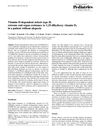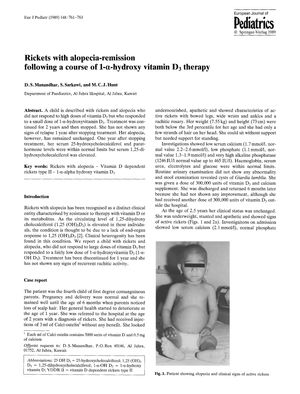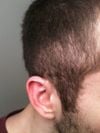TLDR Child with rickets improved with a specific vitamin D therapy, but alopecia did not change.
In the 1989 study, a child with rickets and alopecia who did not improve after receiving high doses of vitamin D3 showed remission following treatment with a low dose of 1-α-hydroxyvitamin D3 (1-α-OH D3). The treatment with 1-α-OH D3 was administered for 2 years, and upon discontinuation, the child did not exhibit any signs of rickets relapse after 1 year. However, the alopecia remained unchanged. After stopping treatment, the child's serum 25-hydroxycholecalciferol and parathormone levels were normal, but serum 1,25-dihydroxycholecalciferol was elevated. This case suggests that the child's condition did not conform to the typical classification of vitamin D dependent rickets type II (VDDR II), as the good response to physiological doses of 1-α-OH D3 is more characteristic of VDDR type I. The temporary requirement for 1-α-OH D3 therapy in this case is notable, and it remains unclear whether the child would have recovered without treatment.
 50 citations
,
October 1986 in “European journal of pediatrics”
50 citations
,
October 1986 in “European journal of pediatrics” A boy with severe Vitamin D-resistant rickets did not respond to treatment and lacked a common symptom, suggesting a need for alternative treatments.
110 citations
,
November 1984 in “The American Journal of Medicine” A genetic defect in vitamin D receptors causes severe rickets and hair loss in children, but some heal as they age.
88 citations
,
October 1983 in “The Journal of clinical endocrinology and metabolism/Journal of clinical endocrinology & metabolism” Patients with this syndrome can have different responses and worsening resistance to treatment over time.
82 citations
,
October 1980 in “The Journal of Clinical Endocrinology & Metabolism” The child's body didn't respond well to vitamin D, causing hair loss and rickets.
170 citations
,
May 1979 in “The journal of pediatrics/The Journal of pediatrics” Two sisters with rickets and hair loss had a genetic issue with vitamin D processing, and only improved when given phosphorus supplements.
151 citations
,
June 2010 in “Endocrinology and metabolism clinics of North America” Two rare genetic diseases cause severe rickets in children due to defects in vitamin D metabolism.
 82 citations
,
April 1981 in “Clinical endocrinology”
82 citations
,
April 1981 in “Clinical endocrinology” A girl with rickets and hair loss was found to have a rare condition where her body didn't respond to vitamin D treatment.
96 citations
,
August 1995 in “Bone” Vitamin D3 is important for bone health and may help treat various diseases beyond bone-related conditions.
276 citations
,
April 2003 in “Molecular endocrinology” Vitamin D is important for bones, hair, blood pressure, and breast development.
378 citations
,
February 2020 in “Nature Reviews Endocrinology”




